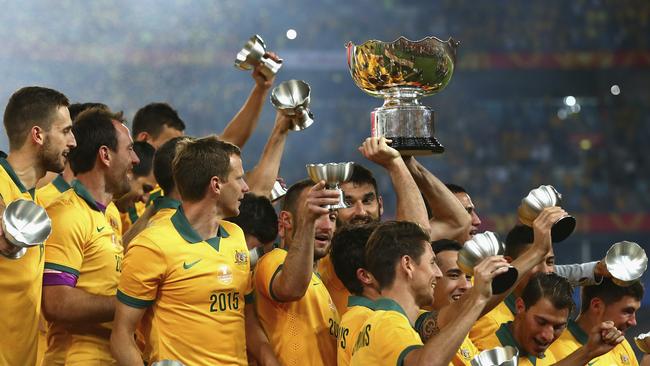Asian Cup 2015: as tempting as it is to say football’s made it in Australia, there’s still work to do
ARE we there yet? It’s the old question we ask on a long journey; while it’s tempting for football to say yes after the Asian Cup, it’s not just yet.

Asian Cup
Don't miss out on the headlines from Asian Cup. Followed categories will be added to My News.
ARE we there yet?
A question asked by many a child on a long journey. It’s an understandable one too. Waiting for the final destination is a frustrating pastime, particularly when you are young.
Football in Australia (or at least the latest professional incarnation of it), is at that juncture at the moment - and, as tempting as it would be to say “yes, it’s just around the corner” - the answer, even after Australia’s stunning Asian Cup success, has to be no - not yet.
What Saturday’s triumph does, is put another building block in place. The Socceroos are the nations darlings once again. After being on the nose for some time, that’s an achievement in itself - and under Ange Postecoglou, there is unlikely to be a return to the days when the ‘Roos and their fans seemed destined for the divorce courts. Their continued success remains vital to the health of the game.
Yet, even as Mile Jedinak was stepping up to collect the trophy, trouble was brewing in Newcastle, as Nathan Tinkler missed Saturday’s midnight deadline to settle outstanding bills - money owed to creditors who, FFA insist, must be paid, if he is to continue as owner of the embattled club.
Whatever the rights & wrongs of the situation (and there are many rumours emanating from the Hunter as to exactly who is to blame), FFA will surely step in soon, before the 10,000-strong membership dwindles away. Those loyal fans deserve better.
Then, there is the situation in Gosford, where only the implosion at the Jets has deflected attention away from some very real concerns over the future direction of the Central Coast Mariners. Likewise, across the ditch, David Gallop put Wellington Phoenix on notice pre-season, telling the assembled media throng that they weren’t “bringing enough to the table.”
The game in Australia is only as strong as its weakest link, and we still have a few creases to iron out.
On that note, longer-term, there remains the thorny issue of how, when, or even if, to adopt a system of promotion and relegation, that most fundamental of building blocks, in any football culture.
The Asian Football Confederation insists this is a non-negotiable for continued membership - even Frank Lowy admits that eventually, Australia must have it. Is there a solution? Maybe. And oddly, the answer may come from Rugby League.
For several years in the British Super League, relegation was put on hold, and clubs (from the second tier), could only gain a promotion “licence” for the top flight if they fulfilled certain criteria.
Firstly, they needed to win the Grand Final. Secondly, they needed to have a stadium with a 10,000 plus capacity. Thirdly, they were not to have been insolvent over a set period; fourthly, they needed to have a healthy turnover, and finally, an average attendance over a threshold figure was required.
If clubs met all those criteria, they were eligible to be considered for promotion. This gave incentive to the smaller clubs, while protecting those in the top flight.
With certain amendments, I believe this system of structured promotion could work for football in Australia - which will not be ready for relegation (in my opinion) for many years yet, for reasons well documented elsewhere.
Specifically, the existing A-League clubs would have a vote (collectively) as to who was to join their ranks - especially as it would lead to a reduction in TV cash for each outfit. At the moment, the A-League clubs have no representation on the FFA board, a situation which cannot continue. Secondly, the licence would be of limited term only, renewable annually up to a qualifying period of say, five years, by which time FFA could consider a longer-term commitment - if the criteria continued to be fulfilled.
Thirdly, all new clubs would have to prove beyond reasonable doubt that all aspects of their operation were not only broad based, but also fully open to, and inclusive of, all segments of their community - at least in intent.
This “carrot and stick” approach would potentially offer the chance of a return to the top flight for (for example) former NSL clubs, but with protective measures put in place, to prevent a return to the days when clubs represented only one part of the local community. The criteria would apply to existing A-League clubs too, to ensure everyone keeps their house in order.
I wouldn’t expect such plans to be put in place until after the next TV deal is agreed. But isn’t now a good time to properly construct the criteria, and tell ambitious clubs exactly what they need to do, to progress to the top tier?
As we bask in the warm glow of Asian Cup glory, and the resounding success of the FFA Cup, there will never be a better chance to fully integrate the game, once and for all.
Maybe, when that is achieved, we can then say “we’re here!”
Originally published as Asian Cup 2015: as tempting as it is to say football’s made it in Australia, there’s still work to do


